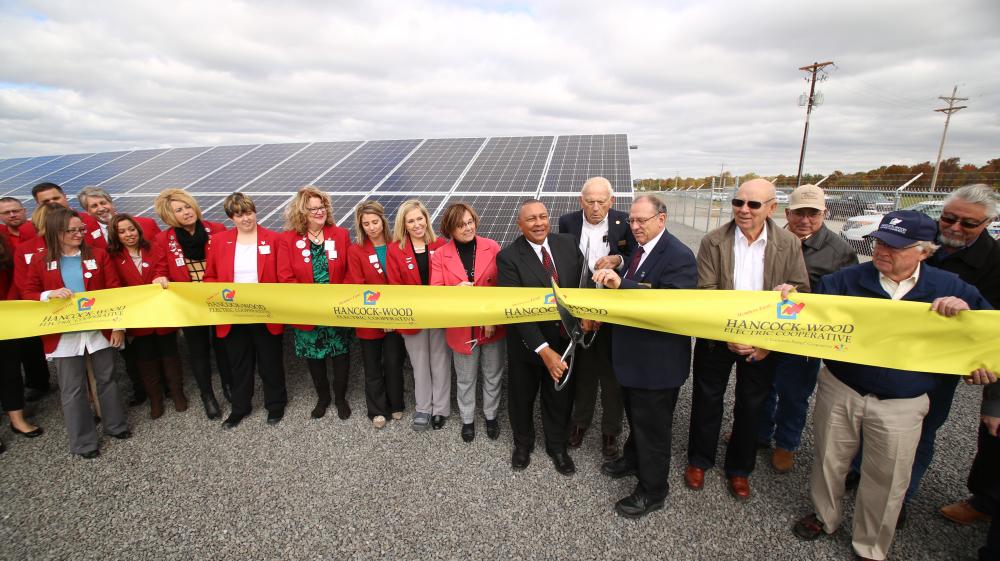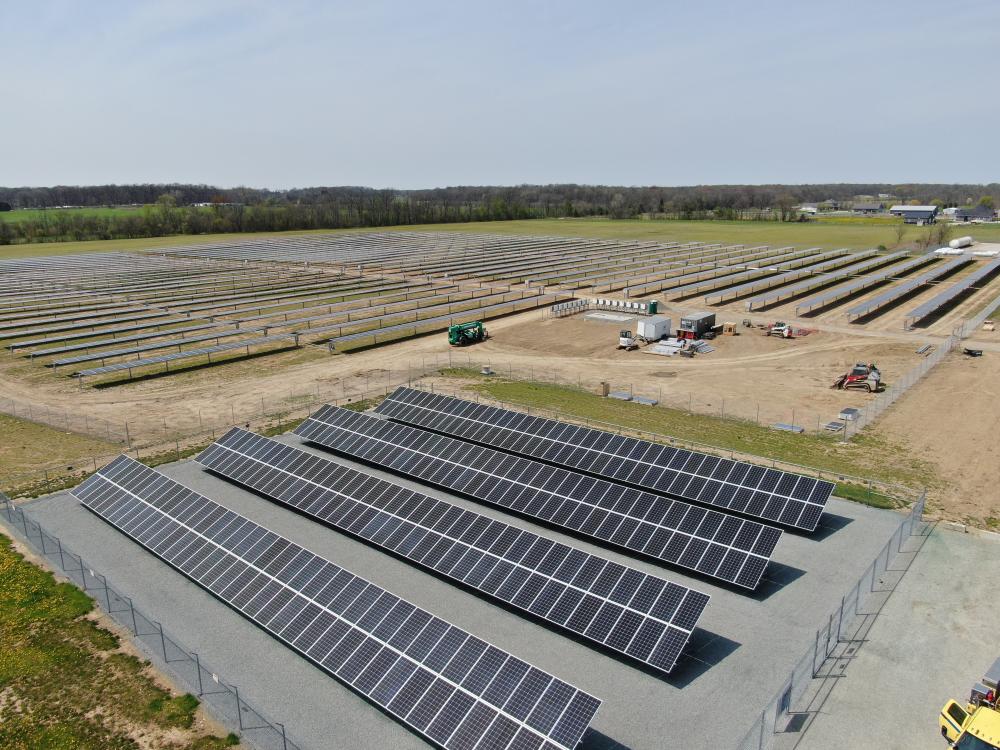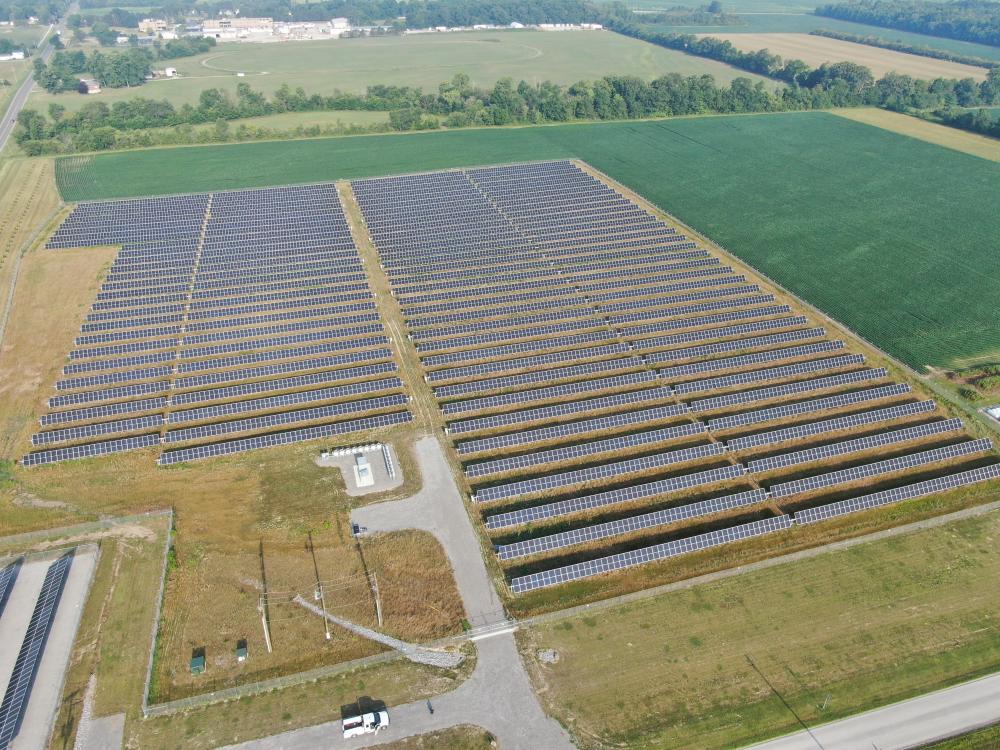
The OurSolar community solar program for residential members makes renewable energy easy and affordable! To learn more about participating in OurSolar call 800-445-4840.
This OurSolar program provides Members the opportunity to purchase a subscription to clean energy from the solar array located at the corner of U.S. 224 and Marion T.R. 215, east of Findlay.
Members can subscribe to the energy output of up to 10 panels. Hancock-Wood will measure the green energy produced by each panel every month and calculate it into the Member’s bill.
OurSolar Project Highlights
Groundbreaking Ceremony

The OurSolar Groundbreaking Ceremony was held on August 19, 2016, marking the official start of Hancock-Wood Electric Cooperative’s community solar initiative. U.S. Congressman Bob Latta, along with board leadership and staff, participated in the event. The OurSolar project is designed to offer renewable, convenient, and affordable energy options to Hancock-Wood members, reflecting the co-op’s dedication to sustainable and member-focused energy solutions.
Phase I Construction

Phase I construction began in August 2019. The project is located at the corner of U.S. 224 and Marion T.R. 215, east of Findlay. This location is accessible and suitable for solar field development.
Phase I Ribbon Cutting Ceremony

After three months of construction, Phase I of the OurSolar Project was completed. A ribbon-cutting ceremony was held on October 24, 2016, to celebrate the milestone. Co-op President George Walton, members of the Hancock-Wood Board, and other members gathered to mark the successful launch of the initiative. A total of 304 solar panels were installed during this initial phase, laying the foundation of this project.
Phase II Construction

Phase II of the OurSolar Project began in Fall 2021. This phase aimed to increase the availability of community solar to Hancock-Wood members by significantly boosting generation capacity.
Phase II Complete

In Summer 2022, Phase II was completed, ending the OurSolar project. With this final phase, nearly 8,000 solar panels were successfully installed and made available for use by cooperative members. This expansion significantly increased the capacity of the solar array, providing more opportunities for members to subscribe to clean, locally generated solar energy. The completion of Phase II not only enhanced the program's environmental impact but also reaffirmed Hancock-Wood's commitment to offering sustainable and forward-thinking energy solutions to the communities it serves.
OurSolar Today

Today, nearly 1,100 solar panels are actively in use by Hancock-Wood Electric Cooperative members through the innovative OurSolar community solar project. This program enables members to access the benefits of solar energy without the need to purchase or install panels on their own property. By participating in the shared solar array, members can reduce their carbon footprint, support clean energy, and enjoy a convenient, cost-effective alternative to traditional home solar systems.
OURSOLAR FREQUENTLY ASKED QUESTIONS
OurSolar is not intended as a cost savings initiative but as an alternative to pricey rooftop solar. Cost-effective coal-fired fuel is a large percentage of our generation portfolio but we encourage the use of renewable energy sources as they become more practical and affordable. In time, solar may become more affordable (see How does OurSolar work). We already offer wind, solar, biomass and hydro as part of your power mix, but some Members requested more green energy – OurSolar fills that need. Want to save energy costs in other ways? Visit hwe.coop/save-energy
On a first-come, first-served basis, you can subscribe to the energy output of up to 10-3’x6’ panels. You sign up for a 5 or 10 year agreement. You can stop subscribing before the contract is up for a fee, but there is no fee if you move or in the event of a Member’s passing. Future costs may rise for traditional energy sources but, for the contract duration, the rate will remain the same – a nice benefit. Hancock-Wood does not profit from OurSolar as an energy distribution co-op. Construction costs were covered through an initiative of Buckeye Power, Inc., our generation company – another great benefit!
Your monthly bill will provide the same information with an addition of an Our Solar charge - for the energy you are puchasing, and an OurSolar credit - for the amount of traditional energy sources you did not use.
Here is the best part - you have the power to choose.
You can choose how or if you wish to participate. If you are not interested – you don’t need to do anything. If you are, you have the opportunity to subscribe to OurSolar.
9.29 cents per kWh. There is no per-panel or fixed fee. Subscribers purchase energy output, not panels.
Cost is fixed for 5 or 10 years, depending on the contract.
This will depend on Member interest because Hancock-Wood and the OurSolar project is Member-driven.
Yes.
No. The entire site will be metered at a single point, and subscribers will be allocated their portion of the array’s output; however, there are alarms built into each power optimizer. If a pair of panels fails to operate as well as the surrounding panels, maintenance crews will be alerted.
4.1MW total statewide.
Average Annual Output = .06% of HWE's annual needs
Not at this time.
Absolutely. Aside from being lower in cost, not all rooftops can accommodate solar panels. OurSolar provides an off-site option with all the benefits and none of the hassle or maintenance.
It is expected that wholesale rates will exceed the OurSolar rate sometime during the project’s lifetime and at that point you may realize a savings.
Net Metering is another co-op program that allows members to purchase, install and own their own solar or wind generation. OurSolar is a community solar program, which translates to lower costs and more opportunity for participation than rooftop solar. Hancock-Wood offers both.
Community Solar is certainly not a fad. In comparison, if you were to factor in property taxes, insurance, maintenance, economy of scale and capital costs of rooftop solar, centralized solar arrays like OurSolar make more economic sense than multiple rooftop arrays.
Solar alone does not improve transmission reliability. Reduction in transmissions costs were factored in to OurSolar.
For the average residential Member subscribing to 10 panels, about 25%.
Most kinds of energy generation need some kind of burn, like coal or gas, to create steam, which turns turbine blades to create rotational energy to a rotor – and energy is generated.
Solar panels skip the burn process by allowing particles of light, called photons, to knock electrons off atoms, generating a flow of electricity. Each panel is made up of photovoltaic cells. Each cell is made up of two layers of semiconducting material, usually silicon at the top and a thicker boron layer at the bottom.
Phosphorus is added to the top layer which adds electrons, providng a negative charge. The bottom has fewer electrons, producing a positive charge. That establishes an electric field between the layers. The field pushes electrons out of the layers at a junction where they meet. The released electrons flow from the junction into conducting plates on the sides, which transfer them to wires where the energy can flow like any other source of electricity.
Solar panels can produce even on cloudy and rainy days and prices have become more affordable - allowing the co-op to offer the community solar service. Lack of efficient battery storage remains the barrier to cost effectiveness in comparison to coal. Solar is only 30 percent as cost effective as coal but remains a renewable energy source at the center of much research and development.
